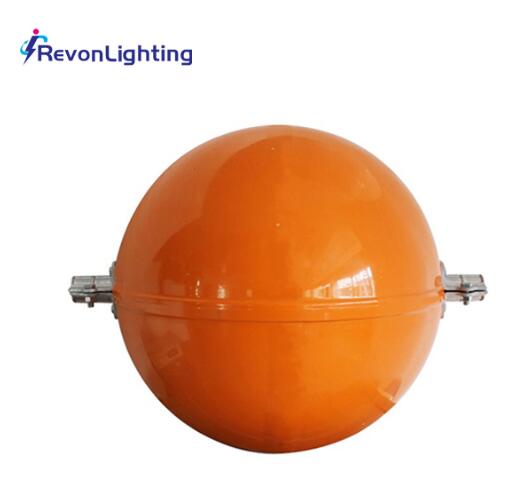Posted: 2024-07-08
Power line marker balls, often seen as bright, conspicuous spheres strung along high-voltage power lines, play a crucial role in aviation safety and infrastructure visibility. These simple yet effective devices are essential for preventing accidents, guiding aerial navigation, and ensuring that power lines are visible to both pilots and the general public. This article explores the importance, functionality, applications, and future prospects of power line marker balls, highlighting their role in enhancing safety and visibility.
Importance of Power Line Marker Balls
Power lines, particularly those that span long distances and cross over or near populated areas, pose a significant risk to low-flying aircraft, including helicopters, light aircraft, and even drones. Marker balls serve as visual indicators that alert pilots to the presence of these potentially dangerous obstacles. By marking power lines, these balls help prevent collisions and ensure safe navigation for aircraft.
In addition to their importance in aviation safety, power line marker balls also serve a critical function in maintaining the integrity of the power grid. They make power lines more visible to ground personnel, reducing the risk of accidental damage during construction or maintenance activities.
Functionality and Design
Power line marker balls are designed to be highly visible and durable. Here are some key features and considerations in their design:
Visibility: Marker balls are typically brightly colored, often in orange, red, yellow, or white. These colors are chosen for their high visibility against various backgrounds and lighting conditions. Some marker balls also have reflective surfaces or incorporate lights to enhance visibility during low-light conditions or at night.
Material: They are made from robust materials such as UV-stabilized plastic, which can withstand harsh weather conditions, including extreme temperatures, wind, rain, and UV radiation. This durability ensures that they remain effective for long periods without needing frequent replacement.
Size and Weight: The size of marker balls can vary, but they are usually between 20 to 36 inches in diameter. They are lightweight enough to be installed on power lines without causing undue stress or sagging but sturdy enough to remain securely attached.
Installation: Marker balls are typically installed at regular intervals along the power line. The spacing and positioning are determined based on regulatory guidelines, which consider factors such as the height of the power lines, proximity to flight paths, and surrounding terrain.

Applications of Power Line Marker Balls
Power line marker balls are used in a variety of settings, each critical for ensuring safety and visibility:
Aviation Safety: The primary application of marker balls is to enhance the visibility of power lines to pilots. They are commonly installed near airports, along flight paths, in areas with low-flying aircraft activity, and near helipads. By marking these lines, pilots can navigate safely, avoiding collisions with the wires.
Urban Areas: In cities and densely populated areas, power lines often cross over roads, buildings, and other structures. Marker balls help ensure that these lines are visible to both aircraft and ground personnel, reducing the risk of accidents and facilitating maintenance work.
Rural and Remote Locations: In rural areas, power lines often span large distances over open terrain, where they may be less visible. Marker balls enhance the visibility of these lines, preventing accidental damage by farm machinery, recreational vehicles, and other ground-based activities.
Utility Infrastructure: Power companies use marker balls to mark lines crossing rivers, valleys, and other geographical features where the lines might blend into the landscape. This not only aids in aviation safety but also helps utility workers locate and identify lines during inspections and repairs.
Regulatory Guidelines and Standards
The use and installation of power line marker balls are governed by regulatory guidelines and standards to ensure consistency and effectiveness. In the United States, the Federal Aviation Administration (FAA) provides detailed regulations on the marking and lighting of obstacles that pose hazards to air navigation. These guidelines specify the color, size, and spacing of marker balls based on the height of the power lines and their proximity to flight paths.
Similarly, other countries have their regulatory bodies that oversee the implementation of safety measures for power lines. Compliance with these standards is essential for maintaining aviation safety and ensuring the visibility of power lines.
Future Prospects and Innovations
The future of power line marker balls is likely to see continued innovation and improvement. Here are some trends and developments to watch for:
| power line marker balls | power line marker ball |
| 300mm | 600mm |
Advanced Materials: Research into new materials could lead to marker balls that are even more durable and weather-resistant, further reducing maintenance needs and extending their lifespan.
Integrated Lighting: Incorporating advanced lighting technology, such as solar-powered LEDs, could enhance the visibility of marker balls at night and in low-light conditions. This would provide an added layer of safety for nighttime aviation and ground-based activities.
Smart Technology: The integration of smart technology and sensors could enable remote monitoring and maintenance of marker balls. This could include detecting damage, tracking environmental conditions, and alerting maintenance crews when replacement or repairs are needed.
Environmental Considerations: Innovations in eco-friendly materials and sustainable manufacturing processes could reduce the environmental impact of marker balls. This would align with global sustainability goals and contribute to greener infrastructure practices.
Conclusion
Power line marker balls are a critical safety measure in the aviation and utility industries. By providing clear visual markers for power lines, they help prevent collisions, enhance navigation, and protect vital infrastructure. As technology continues to advance, the design and functionality of marker balls will likely improve, offering even greater durability, visibility, and smart capabilities. These developments will ensure that power line marker balls remain an essential tool for safeguarding our skies and maintaining the integrity of the power grid.